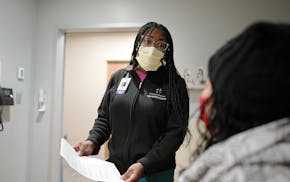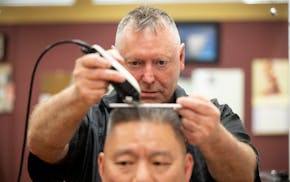The several-year founder of a growing aeroponic farm near Faribault is ready to prove his Living Greens low-input, no-dirt operation will have a big effect on the emerging world of year-round indoor vegetable growing.
CEO Dana Anderson, 50, a former financial adviser who worked on farms as a youth near Spicer, Minn., started tinkering with aeroponics in his Prior Lake garage in 2010.
Last year, Living Greens, staked by $8 million over several years contributed by founding shareholders, started slowly by testing and eventually producing increasingly larger crops of lettuce with a high-tech, rapid-growth system rooted in nutrient-rich misting and LED lighting.
By early next year, following completion of the last stage of construction, Living Greens should amount to 60,000 square feet of stacked, mechanized growing space capable of producing up to 3 million heads of high-quality lettuce.
That's several fast-growing crops in one year.
The business plan and initial production proved impressive enough to recently draw $12 million in an inaugural round of institutional funding from Boston-based private-equity funds NXT and Wave Equity Partners.
"We're exiting the research-and-development stage and going to market," Anderson said.
The $6 million Faribault factory-farm will prove Living Greens' technology innovation and its year-round, premium-lettuce model and spur construction of a second plant within a year outside of Minnesota, backers said.
"We think we have an opportunity to be a market leader in leafy greens," Anderson said. "There are projections nationally that up to 50 percent of leafy greens could be grown indoors within 10 years from almost nothing today.
"Our goal is to be the largest indoor [farm operation]; corporate-owned and through licensing of the technology," Anderson said. "We're looking at joint ventures with food-service companies around the world."
Living Greens said that its Faribault farm — a floor footprint of about 20,000 square feet that rises to about 16 feet, thus providing its 60,000 square feet of growing space — will be the second-largest aeroponics operation behind that of industry leader AeroFarms of Newark, N.J. It operates a 70,000-square-foot indoor farm in addition to smaller installations.
Living Greens already supplies a growing list of Minnesota and Wisconsin grocers with several types of leaf lettuce, arugula and mixed greens through Robinson Fresh, a division of C.H. Robinson.
By next year, it will have installed the technology to produce around 3 million bagged packages of salad greens for retail distributions.
Typical salad bags, depending on whether they include dressing and other ingredients as part of planned "salad kits," will retail for $2.99 to $3.99.
"We're producing about 500,000 units a year now, and it will be a sixfold expansion by spring," Anderson projected.
The 20-employee Living Greens operation includes chief technology officer Dave Augustine, a University of Minnesota-trained electrical engineer and veteran industrialist who joined the board several years ago.
Augustine, 55, who grew up on a farm, was a several-year board member who stepped into the executive ranks as overseer of the company's technology integration.
Living Greens has been awarded four patents on its growing process, according to Anderson.
The firm plans to produce as much lettuce indoors as would be produced by 100 times the farmland, using 95 percent less water, no pesticides, herbicides or other chemicals.
It does so thanks to its density and computer-controlled environment that blends natural light and ultraefficient LED lighting that has dramatically dropped in price in recent years thanks to widespread business and residential embracement.
"The price has been dropping by about 20 percent a year as illumination has increased by about 50 percent," Anderson said. "The risks of foodborne illness are extremely muted compared to the traditional food chain. We use a 'reverse-osmosis' process to remove all the particulates from the water."
Then there's the local pitch.
Living Greens plans to deliver a premium product locally, at lower cost, because it won't have the long-haul transportation expense and up to two weeks' time to deliver from Mexico or the California-Texas Sun Belt where most fall-winter vegetables are grown.
To be sure, Living Greens has dreams of being a big company in a fragmented but fast-developing indoor agriculture market.
They include Revol Greens, the Minnesota-based greenhouse grower that has added some water- and energy-conserving wrinkles of its own, as well as Plenty, the California-based indoor grower that has raised $200 million and also has its eyes on China.
The sector is driven by the premise that farmland is limited, and industrial-scale farming can be very expensive and uses what can be unsustainable amounts of water, chemicals and land.
The challenge for the small, indoor innovators such as Living Greens is to entice buyers with tasty produce at a competitive but profitable price that customers also will patronize for their regional and environmental pitches.
"This took us longer and cost us more than we'd hoped, but I think we have a better system and technological lead," Anderson said. "It's a tremendous opportunity because of the demand for fresh, year-round local produce."
Neal St. Anthony has been a Star Tribune business columnist and reporter since 1984. He can be contacted at nstanthony@startribune.com.

St. Anthony: 'Patient' investing paying off for St. Paul's Hill Capital

Jennifer Smith, leader of Burnsville's Innovative Office Solutions, has died

St. Anthony: Medical professions in Minnesota need more people of color in their ranks


